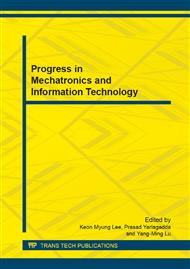[1]
P.F. Villard, M. Beuve, and B. Sharit, An Approach to Convert 4D Geometry into a 4D CT Scan, WSCG 2006 conference proceedings, Plzen, Czech Republic, January 30 - February 3, (2006).
Google Scholar
[2]
Nicole M. Wink, Christoph Panknin, and Timothy D. Solberg , "Phase versus amplitude sorting of 4D-CT data, JOURNAL OF APPLIED CLINICAL MEDICAL PHYSICS, VOLUME 7, NUMBER 1, WINTER 2006, pp.77-85.
DOI: 10.1120/jacmp.v7i1.2198
Google Scholar
[3]
Keall P. 4-dimensional computed tomography imaging and treatment planning. Semin Radiat Oncol. 2004; 14 (1): 81–90.
Google Scholar
[4]
Suresh Senan, and Frank J Lagerwaard, Current Status of Four-dimensional Computed Tomography for High-precision Radiotherapy, Radiotherapy & Imaging, T O U C H B R I E F I N G S 2 0 0 7, pp.98-101.
DOI: 10.17925/eoh.2007.0.1.88a
Google Scholar
[5]
Rietzel E, Pan T, Chen GT, Four-dimensional computed tomography: image formation and clinical protocol, Med Phys, 2005; 32: 874–89.
DOI: 10.1118/1.1869852
Google Scholar
[6]
Rongping Zeng, Jeffrey A. Fessler, James M. Balter, ITERATIVE SORTING FOR 4DCT IMAGES BASED ON INTERNAL ANATOMY MOTION, Biomedical Imaging: From Nano to Macro, 2007. ISBI 2007. 4th IEEE International Symposium on, pp.744-747.
DOI: 10.1109/isbi.2007.356959
Google Scholar
[7]
T. Pan, T-Y. Lee, E. Rietzel, and G. T. Y. Chen, 4D-CT imaging of a volume influenced by respiratory motion on multi-slice CT, Med. Phys., vol. 31, no. 2, Feb. 2004, pp.333-340.
DOI: 10.1118/1.1639993
Google Scholar
[8]
D. A. Low, M. Nystrom, E. Kalinin, P. Parikh, A method for the reconstruct of four-dimensional synchronized CT scans acquired during free breathing, Med. Phys. 30, 2003, pp.1254-1263.
DOI: 10.1118/1.1576230
Google Scholar
[9]
L. S. Johnson, S. W. Hadley, and C. A. Pelizzari, A video-based technique to gate radiotherapy treatments for respiration, Int. J. Radiat. Oncol., Biol., Phys. 42, 1998, pp.139-143.
DOI: 10.1016/s0360-3016(98)80131-4
Google Scholar
[10]
Kumar, S., Ramos, F.T., Upcroft, B. & Durrant-Whyte, H.F. A Statistical Framework for Natural Feature Representation, Proceedings of the IEEE/RSJ International Conference on Intelligent Robots & Systems, 2005 pp.1-6.
DOI: 10.1109/iros.2005.1544950
Google Scholar
[11]
Kajetan Berlinger, _Otto Sauer and Lucia Vences, A simple method for labeling CT images with respiratory states, Med. Phys. 33(9), September 2006, pp.3144-3148.
DOI: 10.1118/1.2229420
Google Scholar
[12]
Roweis, S.T., Saul, L.K.: Nonlinear dimensionality reduction by locally linear embedding. Science 290, 2323–2326 (2000).
DOI: 10.1126/science.290.5500.2323
Google Scholar
[13]
A. Errity, J. McKenna, and B. Kirkpatrick, Manifold learning-based feature transformation for phone classification, in Proc. of the ISCA Tutorial and Research Workshop on Nonlinear Speech Processing (NOLISP), Paris, France, May 2007, pp.43-46.
DOI: 10.1007/978-3-540-77347-4_10
Google Scholar


